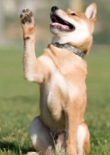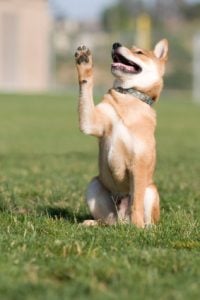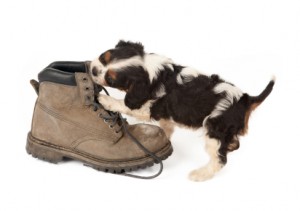How to Train a Puppy During Your First 30 Days
By Sally Gutteridge | Posts

 Bringing a puppy home for the first time is a fun and exciting occasion. That is, until reality sets in, and you realize that you have quite a bit of work on your hands when it comes to house training and stopping a brand-new puppy from chewing and barking.
Bringing a puppy home for the first time is a fun and exciting occasion. That is, until reality sets in, and you realize that you have quite a bit of work on your hands when it comes to house training and stopping a brand-new puppy from chewing and barking.
The first 30 days are the most critical when it comes to how to train a puppy after introducing it to your home. These 30 days will make or break the relationship you have with your pet for the rest of its life. The good news is that you can use helpful training tips to greatly reduce a number of common behavioral issues in new puppies, like:
But where to begin? You must start training your puppy from day one. To train a puppy, you need to communicate in a way that it can understand – which is always in the moment. A puppy can only learn by what you reinforce with a reward or when you punish it for doing something wrong.
 Chewing: If your puppy is playful and spends time playing with its new toys, you can use that opportunity to reinforce. Give a treat and lots of praise and petting to show your puppy that its good behavior has been rewarded.
Chewing: If your puppy is playful and spends time playing with its new toys, you can use that opportunity to reinforce. Give a treat and lots of praise and petting to show your puppy that its good behavior has been rewarded.
On the other hand, if your puppy starts to chew on your sofa, punishment is important to stop the behavior in its tracks. Punish by saying an “AHH!” word to startle it and redirect attention to a chew toy. Once the puppy starts chewing on the toy, reward it immediately.
 Housetraining: The only way to stop a puppy from soiling in the house is to catch it in the act. This is then the opportunity to punish by startling the puppy in the same way with an “AHH!” word and then take it outside. Once the puppy successfully uses the toilet outside, it should be rewarded with a treat, praise, and petting each time.
Housetraining: The only way to stop a puppy from soiling in the house is to catch it in the act. This is then the opportunity to punish by startling the puppy in the same way with an “AHH!” word and then take it outside. Once the puppy successfully uses the toilet outside, it should be rewarded with a treat, praise, and petting each time.
Crate training can be used to effectively establish a housetraining routine for your puppy. Puppies naturally won’t want to soil their sleeping area, so keeping your puppy temporarily crated will make it easier to place it on a toilet schedule. When your puppy doesn’t soil the crate and instead uses the toilet outdoors, praise and reward to reinforce this action.
Biting and Barking: In order to avoid aggressive behavior toward humans and dogs, your puppy must be socialized as soon as possible. Then it can learn how to interact with other dogs and humans of all sizes. This can be best done by taking puppy training classes and even spending time in front of a public place like the supermarket so that your puppy can learn to meet strangers.
Once again, reward all good behavioral interactions immediately; punish the puppy by startling and redirecting attention when you catch it in the act of biting or barking at a stranger.
It’s important not to punish your puppy with hitting or harsh words. Instead, focus most on rewarding good behavior and use the startling technique to redirect and punish bad behavior.
How to Train a Puppy: 3 Important Rules
Timing: As you learn how to train a puppy, keep in mind that timing is of the utmost importance. Make sure to tackle the task of training within at least the first 30 days after bringing your puppy home. If you put it off, your puppy is going to dominate your house and further solidify any bad behaviors it has learned.
Even though you may want to cuddle with and pamper your puppy, training from day one in your home is critical. When it comes to timing to train a puppy, make sure you steer clear of training if your puppy is overly excited, tired, or exploring. If you don’t have the complete attention of your puppy, you will be wasting your time in your training sessions.
Feed your puppy high quality, nutritious dog food three times a day; reduce feedings to twice a day as the puppy grows older. This regular feeding will make a puppy’s bathroom use more predictable so that you can schedule times to take it outside to prevent accidents.
So … What’s next?
Here at the Dog Trick Academy we’re a bunch of dog lovers who enjoy helping new dog owners like you, learn how to train their dog. And we don’t limit ourselves to the basics, oh no, we train all sorts of cool tricks and behaviors that would make your friends amazed.
For more information on how you can start training your dog today, visit our Dog Forum!
Session expired
Please log in again. The login page will open in a new tab. After logging in you can close it and return to this page.
how does it train it to do that stuff and how many day do you have too do that ??
You have to consistently train your dog to have proper house manners until you achieve the desired outcome. The time required will vary from dog to dog and it depends greatly on your timing and reinforcements. Basically, don’t stop training your dog/puppy until you are satisfied with how he is in your home and living with you.
all i want to do is to get my puppy to sit
The best way i found to train my dog to sit was to get his/her favourite treet and hold it infront of them and then with your other hand push down gently on the hind legs of your puppy then say “sit” at the same time and after about a week or two your pup should be getting used to it, this also trained my dog to take food gently from your hand.
Thanks so much for all of your advice, most worked
My mom says if our dog “Joannah” doesn’t stop jumping on my dad we’ll have to get rid of her 🙁 . So how do i train her?
Hi Kailianna, I’ve sent you and e-mail.
It would be better to “lure” the dog into the sit by moving the treat towards his eyes/ears. The method you’ve described is done worked because the discomfort of you pushing on his back was removed when he sat down. In my opinion, it’s better to reward the dog for doing the right behavior.
Thanks for all the great info. But still needing more info….our 9 week German Shepherd wants to chew on our hands and chew/bite our 2 and 5 year olds when they walk or play, any advise would be great:-) thanks!
My dog Rufus jumps and gets over exited so how do I train him